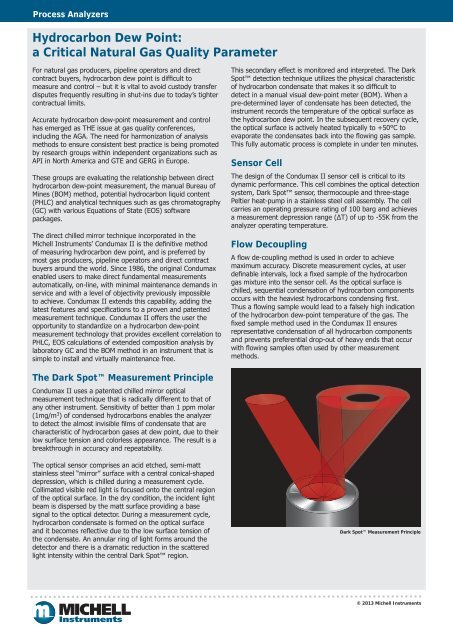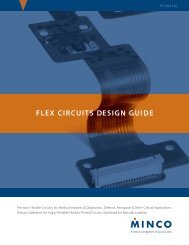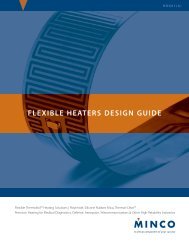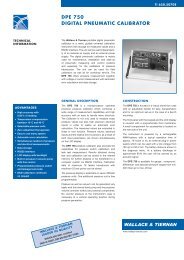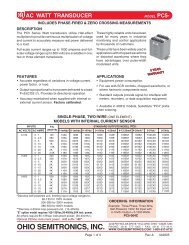Condumax II
condumax II Hydrocarbon dew point analyser - Michell Instruments
condumax II Hydrocarbon dew point analyser - Michell Instruments
- No tags were found...
Create successful ePaper yourself
Turn your PDF publications into a flip-book with our unique Google optimized e-Paper software.
Process Analyzers<br />
Hydrocarbon Dew Point:<br />
a Critical Natural Gas Quality Parameter<br />
For natural gas producers, pipeline operators and direct<br />
contract buyers, hydrocarbon dew point is difficult to<br />
measure and control – but it is vital to avoid custody transfer<br />
disputes frequently resulting in shut-ins due to today’s tighter<br />
contractual limits.<br />
Accurate hydrocarbon dew-point measurement and control<br />
has emerged as THE issue at gas quality conferences,<br />
including the AGA. The need for harmonization of analysis<br />
methods to ensure consistent best practice is being promoted<br />
by research groups within independent organizations such as<br />
API in North America and GTE and GERG in Europe.<br />
These groups are evaluating the relationship between direct<br />
hydrocarbon dew-point measurement, the manual Bureau of<br />
Mines (BOM) method, potential hydrocarbon liquid content<br />
(PHLC) and analytical techniques such as gas chromatography<br />
(GC) with various Equations of State (EOS) software<br />
packages.<br />
The direct chilled mirror technique incorporated in the<br />
Michell Instruments’ <strong>Condumax</strong> <strong>II</strong> is the definitive method<br />
of measuring hydrocarbon dew point, and is preferred by<br />
most gas producers, pipeline operators and direct contract<br />
buyers around the world. Since 1986, the original <strong>Condumax</strong><br />
enabled users to make direct fundamental measurements<br />
automatically, on-line, with minimal maintenance demands in<br />
service and with a level of objectivity previously impossible<br />
to achieve. <strong>Condumax</strong> <strong>II</strong> extends this capability, adding the<br />
latest features and specifications to a proven and patented<br />
measurement technique. <strong>Condumax</strong> <strong>II</strong> offers the user the<br />
opportunity to standardize on a hydrocarbon dew-point<br />
measurement technology that provides excellent correlation to<br />
PHLC, EOS calculations of extended composition analysis by<br />
laboratory GC and the BOM method in an instrument that is<br />
simple to install and virtually maintenance free.<br />
This secondary effect is monitored and interpreted. The Dark<br />
Spot detection technique utilizes the physical characteristic<br />
of hydrocarbon condensate that makes it so difficult to<br />
detect in a manual visual dew-point meter (BOM). When a<br />
pre-determined layer of condensate has been detected, the<br />
instrument records the temperature of the optical surface as<br />
the hydrocarbon dew point. In the subsequent recovery cycle,<br />
the optical surface is actively heated typically to +50°C to<br />
evaporate the condensates back into the flowing gas sample.<br />
This fully automatic process is complete in under ten minutes.<br />
Sensor Cell<br />
The design of the <strong>Condumax</strong> <strong>II</strong> sensor cell is critical to its<br />
dynamic performance. This cell combines the optical detection<br />
system, Dark Spot sensor, thermocouple and three-stage<br />
Peltier heat-pump in a stainless steel cell assembly. The cell<br />
carries an operating pressure rating of 100 barg and achieves<br />
a measurement depression range (ΔT) of up to -55K from the<br />
analyzer operating temperature.<br />
Flow Decoupling<br />
A flow de-coupling method is used in order to achieve<br />
maximum accuracy. Discrete measurement cycles, at user<br />
definable intervals, lock a fixed sample of the hydrocarbon<br />
gas mixture into the sensor cell. As the optical surface is<br />
chilled, sequential condensation of hydrocarbon components<br />
occurs with the heaviest hydrocarbons condensing first.<br />
Thus a flowing sample would lead to a falsely high indication<br />
of the hydrocarbon dew-point temperature of the gas. The<br />
fixed sample method used in the <strong>Condumax</strong> <strong>II</strong> ensures<br />
representative condensation of all hydrocarbon components<br />
and prevents preferential drop-out of heavy ends that occur<br />
with flowing samples often used by other measurement<br />
methods.<br />
The Dark Spot Measurement Principle<br />
<strong>Condumax</strong> <strong>II</strong> uses a patented chilled mirror optical<br />
measurement technique that is radically different to that of<br />
any other instrument. Sensitivity of better than 1 ppm molar<br />
(1mg/m 3 ) of condensed hydrocarbons enables the analyzer<br />
to detect the almost invisible films of condensate that are<br />
characteristic of hydrocarbon gases at dew point, due to their<br />
low surface tension and colorless appearance. The result is a<br />
breakthrough in accuracy and repeatability.<br />
The optical sensor comprises an acid etched, semi-matt<br />
stainless steel “mirror” surface with a central conical-shaped<br />
depression, which is chilled during a measurement cycle.<br />
Collimated visible red light is focused onto the central region<br />
of the optical surface. In the dry condition, the incident light<br />
beam is dispersed by the matt surface providing a base<br />
signal to the optical detector. During a measurement cycle,<br />
hydrocarbon condensate is formed on the optical surface<br />
and it becomes reflective due to the low surface tension of<br />
the condensate. An annular ring of light forms around the<br />
detector and there is a dramatic reduction in the scattered<br />
light intensity within the central Dark Spot region.<br />
Dark Spot Measurement Principle<br />
© 2013 Michell Instruments


